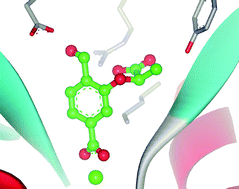Design and synthesis of aromatic inhibitors of anthranilate synthase†
Abstract
Anthranilate synthase catalyses the conversion of chorismate to anthranilate, a key step in tryptophan biosynthesis. A series of 3-(1-carboxy-ethoxy) benzoic acids were synthesised as chorismate analogues, with varying functionality at C-4, the position of the departing hydroxyl group in chorismate. Most of the compounds were moderate inhibitors of anthranilate synthase, with inhibition constants between 20–30 µM. The exception was 3-(1-carboxy-ethoxy) benzoic acid, (C-4 = H), for which KI = 2.4 µM. These results suggest that a hydrogen bonding interaction with the active site general acid (Glu309) is less important than previously assumed for inhibition of the enzyme by these aromatic chorismate analogues.

- This article is part of the themed collection: In memory of Chris Abell

 Please wait while we load your content...
Please wait while we load your content...